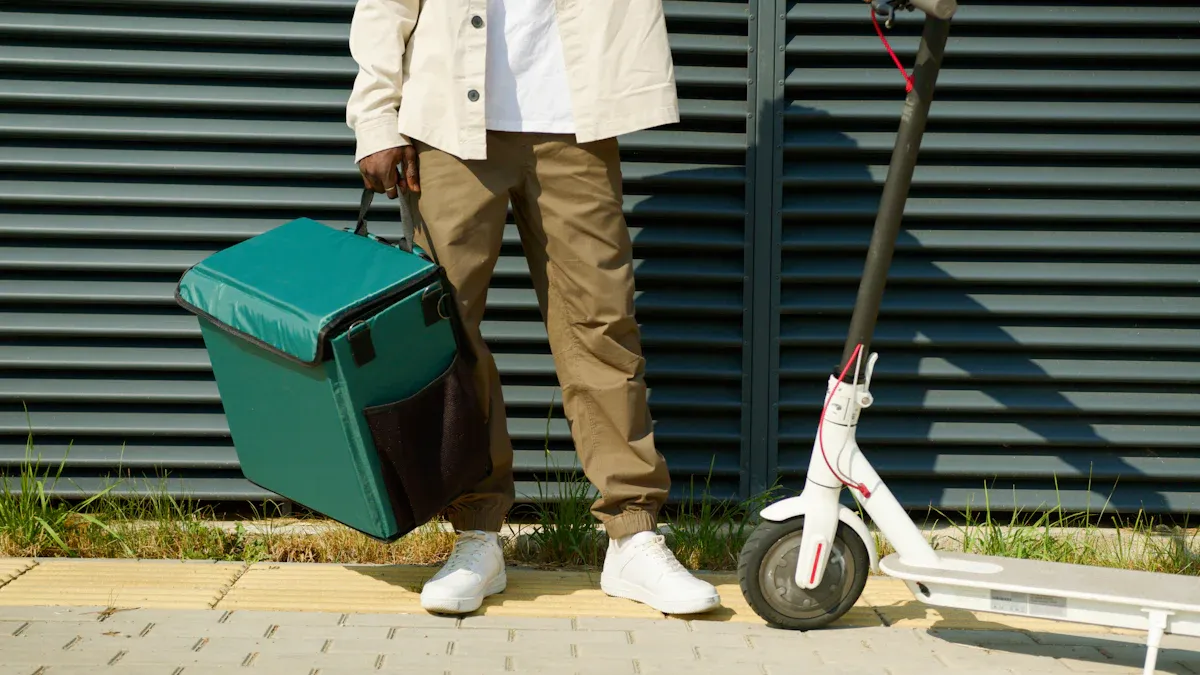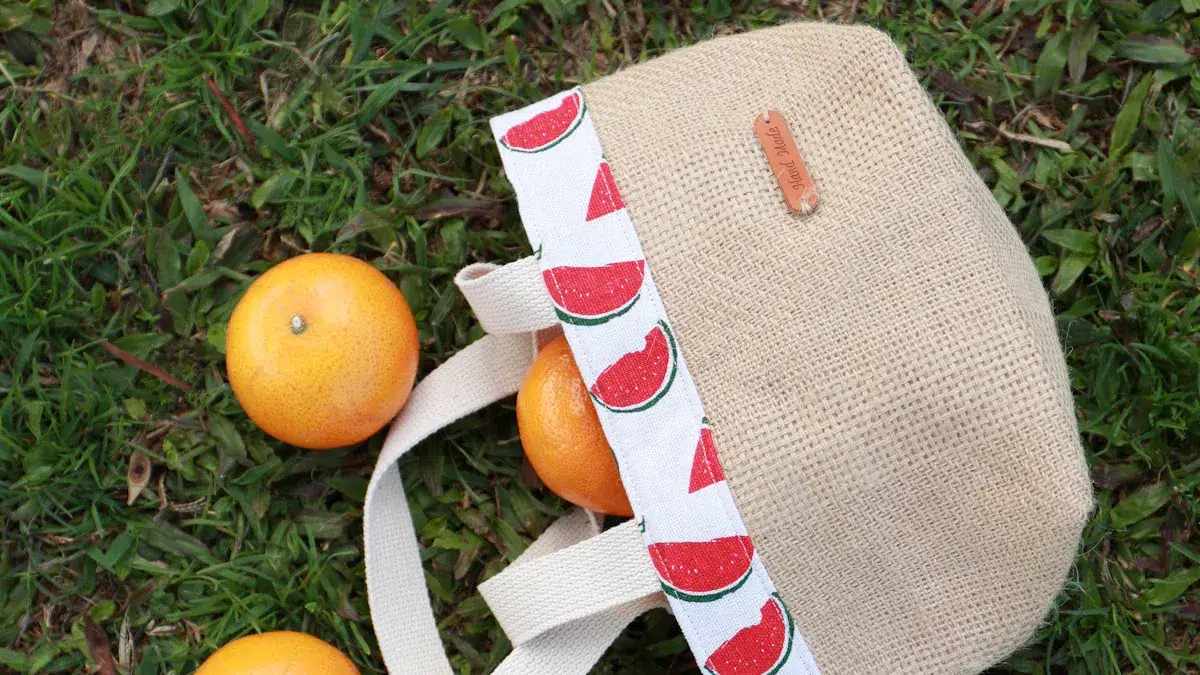
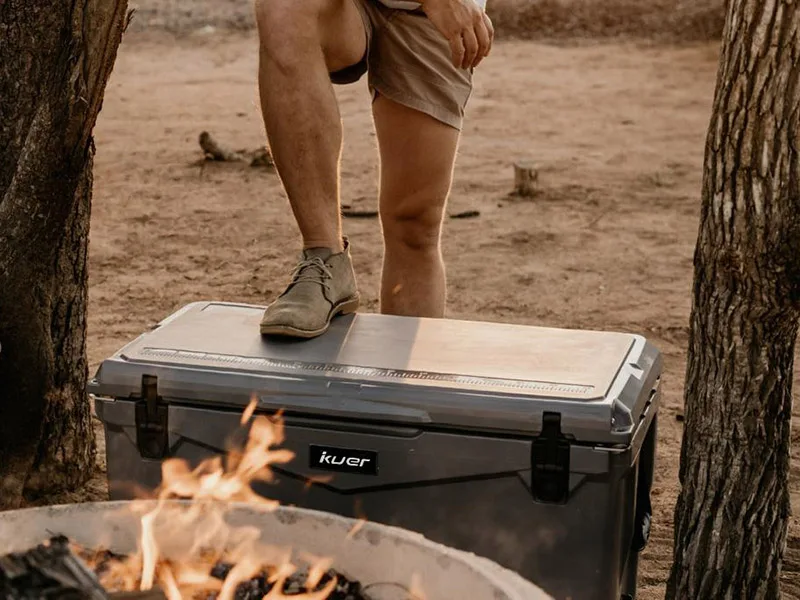
You want the best insulated cool box for your outdoor adventures. Brands like KUER, Yeti, and RTIC lead the market, but KUER stands out with advanced manufacturing and strong research and development. Choosing the right insulated box affects food safety and convenience.
| Cooler Type | Food Safety Impact | Convenience Impact |
|---|---|---|
| Small Coolers | Good for short trips, limited ice retention | Lightweight, easy to carry |
| Mid-sized Coolers | Better temperature control, more storage | Great for groups, longer trips |
| Hard Coolers | Superior insulation, best for long-term use | Heavy but very durable |
| Soft Coolers | Adequate for day trips, easy to pack | Flexible, foldable, very portable |
Smart features and durable designs help keep your food safe and fresh in any outdoor setting.
KUER one of the leading cooler box manufacturers, our design ensure your cooler box performs at its best. If you wonder how does a plastic ice chest work, the answer lies in the science of insulation and smart engineering.
Insulated Cool Box Benefits
For Campers
When you go camping, you need to keep your food and drinks safe and fresh. An insulated cool box helps you do this by keeping everything cold for a long time. Scientific tests show that a high-quality insulated cooler can keep food below 40ºF for up to 7 days. This means you can bring perishable foods like meat, dairy, and fresh vegetables without worrying about spoilage. You do not need electricity because these coolers use ice blocks or frozen bottles. This makes them perfect for remote campsites, fishing trips, or hunting adventures.
Tip: Always pack your cooler bag with enough ice and keep it closed as much as possible. Moisture can reduce insulation by up to 19%, so dry ice packs or sealed ice bottles work best.
You can choose from different types of coolers. Hard-sided insulated coolers offer the best ice retention and durability. They are great for longer trips or larger groups. Soft-sided cooler bags are lighter and easier to carry, making them ideal for short hikes or day trips. Both types help you enjoy fresh meals and cold drinks, even far from home.
For Travelers
If you travel often, you want a cooler that is easy to carry and fits your busy lifestyle. Soft-sided cooler bags give you many advantages. They are lightweight and often come with shoulder straps or backpack designs. You can fold or roll them up when empty, saving space in your car or luggage. Many cooler bags have extra pockets and compartments, so you can organize snacks, drinks, and utensils.
- Soft-sided insulated coolers are made from tough, waterproof materials.
- You can use them for fishing, golfing, beach outings, or picnics.
- They cost less than hard coolers and work well for short trips or frequent use.
A travel cooler lets you keep food and drinks cold on the go. You do not have to stop for ice as often, and you can enjoy fresh snacks wherever you are. The compact design and flexibility make insulated coolers a smart choice for any traveler who values convenience and freshness.
Comparison Criteria
Ice Retention
When you choose a cooler, ice retention is one of the most important factors. Ice retention measures how long your cooler keeps food and drinks cold. Experts test this by filling coolers with ice and checking how much remains after 24 hours or more. For example, in a test with two 8-pound ice bags, the Otter Box Venture 45 kept 7 pounds of ice after 24 hours in direct sunlight, while the Yeti Tundra 65 and Pelican 65 Elite each kept 5 pounds. This shows that top coolers can keep your items cold even in harsh conditions.
| Cooler Brand | Ice Remaining After 24 Hours (lbs) | Test Conditions |
|---|---|---|
| Otter Box Venture 45 | 7 | Two 8-lb ice bags, 6 warm cans, opened 6 times, upper 80s°F, direct sunlight |
| Dometic Patrol 55 | 5 | Same as above |
| Pelican 65 Elite | 5 | Same as above |
| Yeti Tundra 65 | 5 | Same as above |
| Engel 65 High | 4 | Same as above |
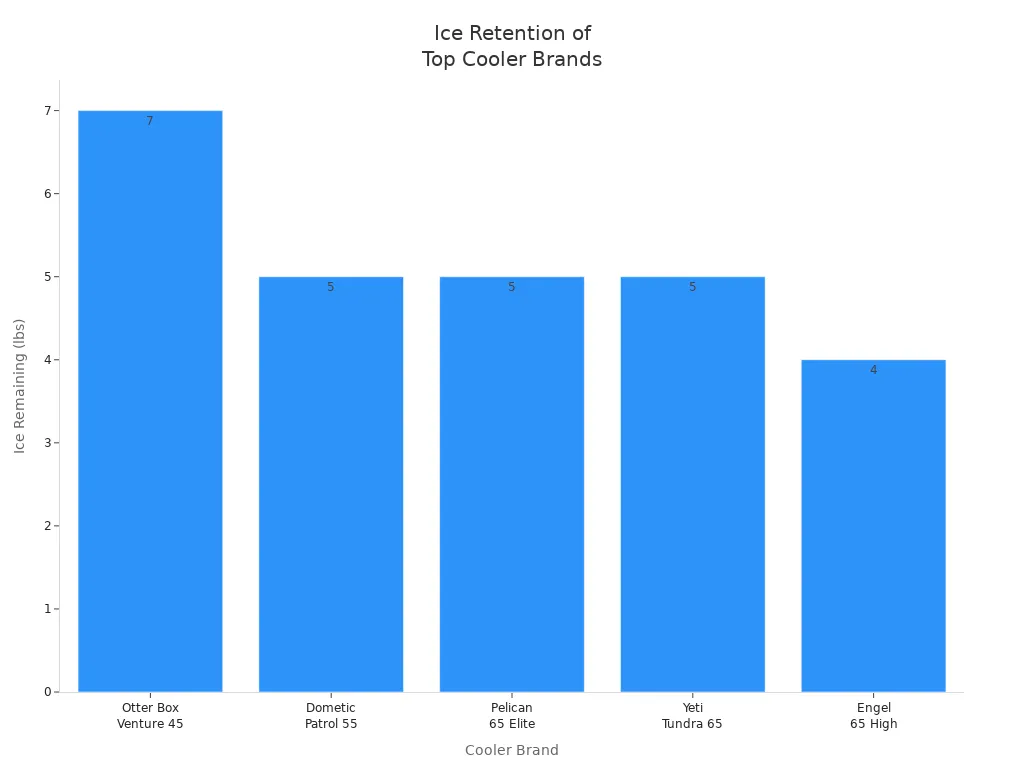
Durability
You want a cooler that can handle rough use. Durability depends on the materials and construction. Coolers made from rotomolded polyethylene, like the Yeti Tundra 65 and KUER 75L Hard Cooler, resist cracking and damage during drop tests. These coolers keep their shape even after being dragged over rocks or used as a seat. Strong hinges, handles, and gaskets also help your cooler last longer.
Portability
A portable cooler makes travel easier. Experts look at weight, handles, wheels, and straps. Soft-sided coolers are lighter and easier to carry, while hard-sided coolers may have wheels for rolling over sand or gravel. Some coolers come with backpack straps or ergonomic handles, so you can carry them comfortably on hikes or to the beach.
Cleaning
Cleaning your cooler keeps food safe and prevents odors. Hard plastic interiors are the easiest to clean and dry quickly. Soft coolers made from polyester or nylon also clean well but may take longer to dry. Look for coolers with wide openings, drain plugs, and water-resistant linings. Designs with fewer seams and compartments make cleaning faster.
Tip: Always dry your cooler completely before storing it to prevent mold and mildew.
Versatility
A versatile cooler fits many activities. Features like multiple compartments, cup holders, and leak-proof lids help you organize food and drinks. Some coolers use advanced insulation with thermal layers for better cold retention. Lightweight designs, adjustable straps, and eco-friendly materials add to the cooler’s usefulness for camping, picnics, fishing, and shopping.
- Leak-proof construction prevents spills.
- Multiple carrying options suit different trips.
- Secure lids and strong insulation keep food safe.
Price
Cooler prices vary by size, features, and brand. Entry-level coolers like the Igloo Ecocool cost about $60 and work well for short trips. Mid-range models such as the RTIC 52 QT Ultra-Light cost around $199 and balance price with performance. Premium coolers like the Yeti Tundra 65 cost about $350 and offer top cold retention and durability. Extra-large coolers, such as the Pelican 80QW Elite, can reach $570 for group trips.
| Cooler Model | Price (USD) | Category | Notes on Features and Use Case |
|---|---|---|---|
| Igloo Ecocool 52 QT | ~$60 | Entry-level | 52-quart capacity, foam insulation, suitable for short trips |
| RTIC 52 QT Ultra-Light | ~$199 | Mid-range | Direct-to-consumer pricing, lighter, good durability |
| Yeti Tundra 65 | ~$350 | Premium | Rotomolded, excellent ice retention and durability |
| Pelican 80QW Elite | ~$570 | Premium/Extra-large | Heavy, bulky, designed for large groups and extended trips |
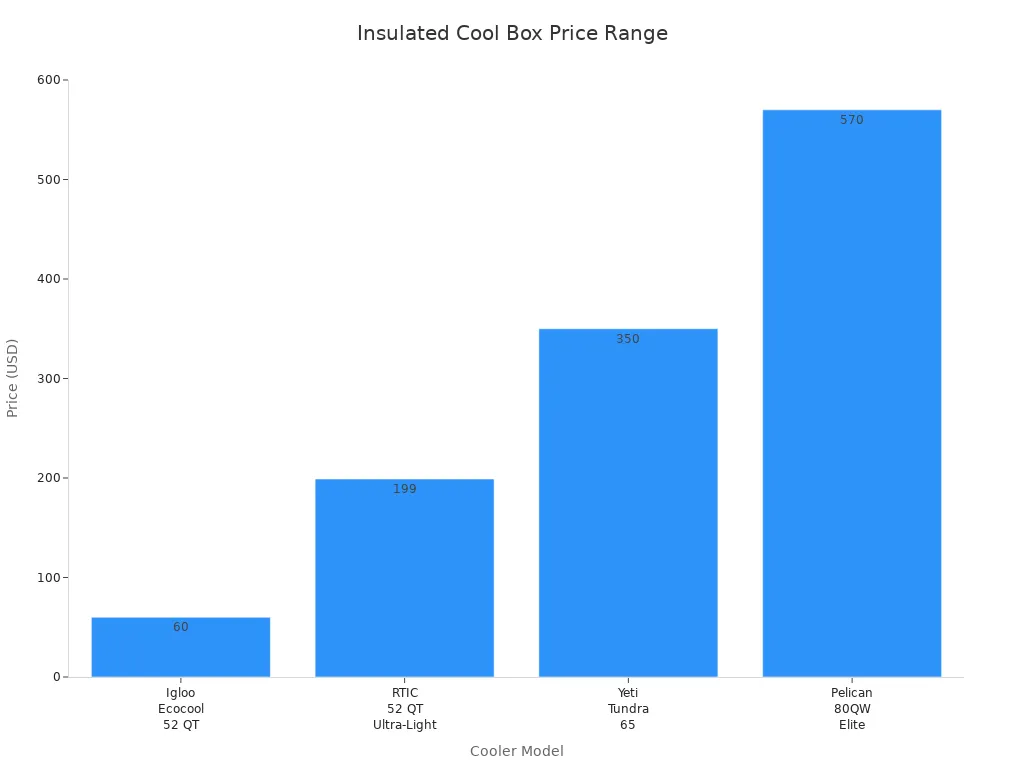
Brand Comparison
Overview
When you look for the best insulated cool box, you find many brands with different strengths. Each brand uses unique materials and manufacturing processes to create products that fit your needs. Some brands focus on high-tech insulation, while others offer simple, budget-friendly options. You see brands like KUER, Yeti, and RTIC leading the market with advanced technology and strong durability. Other brands, such as Coleman and Igloo, give you reliable performance at a lower price. Premium brands like Pelican and Engel use special materials and rugged designs for extreme conditions. You also find innovative brands like RovR and Dometic, which add features for travel and convenience.
You want to know how these brands compare in terms of manufacturing, innovation, and global reach. The table below shows some of the unique materials and processes used by major brands. This helps you understand what makes each cooler stand out.
| Brand | Unique Manufacturing Process / Material | Key Features |
|---|---|---|
| KUER | Integrated production from raw materials to assembly; advanced rotomolding | High daily output, strong R&D, global reach |
| Yeti | Rotomolded construction, premium insulation | Superior durability, long ice retention |
| Orca | Rotomolded, thick walls, custom colors | Lifetime warranty, made in USA |
| RTIC | Direct-to-consumer, rotomolded | Affordable, high performance |
| Coleman | Injection-molded, foam insulation | Lightweight, budget-friendly |
| Igloo | Injection-molded, eco-friendly options | Recycled materials, wide range of sizes |
| RovR | Rotomolded, all-terrain wheels | Mobility, dry storage bin |
| Pelican | Injection-molded, press & pull latches | Extreme durability, certified bear-resistant |
| Engel | Rotomolded, airtight gaskets | Drybox function, marine-grade hardware |
| Dometic | Rotomolded, high-density foam | Focus on travel, lightweight |
| Otter Box | Rotomolded, modular accessories | Customizable, strong latches |
| Lifetime | Blow-molded, UV-protected plastic | Affordable, good insulation |
Note: Some brands use special liners and insulation materials, such as CelluLiner, PopupLiner, EcoLiner, and CooLiner, to improve thermal performance and durability.
Strengths
You want a cooler that matches your adventure. Each brand brings something special to the table.
-
KUER
KUER stands out with its large-scale manufacturing and advanced technology. You benefit from five factories and two trading companies, covering over 70,000 square meters. KUER uses 22 automatic rotomolding machines, two blow molding machines, and three foaming machines. This setup allows KUER to produce up to 1,500 cooler boxes every day. The company stores up to 30,000 boxes in its warehouse and plans to expand with a new 12,000-square-meter factory in Cambodia. KUER controls the process from raw materials to finished products. The R&D team holds over 50 patents and brings years of experience in rotational molding. You get a cooler that combines innovation, quality, and global service. -
Yeti
Yeti uses rotomolded construction and premium insulation. You get a cooler known for toughness and long ice retention. Yeti coolers handle rough use and keep your food cold for days. Many outdoor experts trust Yeti for camping and fishing. -
Orca
Orca coolers use thick rotomolded walls and offer custom colors. You receive a lifetime warranty and products made in the USA. Orca focuses on durability and customer satisfaction. -
RTIC
RTIC gives you high performance at a lower price. The brand uses rotomolded construction and sells directly to you. This approach keeps costs down while offering strong ice retention. -
Coleman
Coleman coolers use injection-molded plastic and foam insulation. You find lightweight and affordable options for family trips. Coleman is a trusted name for generations. -
Igloo
Igloo offers eco-friendly coolers made from recycled materials. You can choose from many sizes and styles. Igloo focuses on value and sustainability. -
RovR
RovR coolers feature rotomolded bodies and all-terrain wheels. You move your cooler easily over sand, gravel, or grass. RovR adds dry storage bins for better organization. -
Pelican
Pelican coolers use injection-molded plastic and press & pull latches. You get extreme durability and certified bear resistance. Pelican coolers work well in harsh environments. -
Engel
Engel coolers use airtight gaskets and marine-grade hardware. You can use them as dry boxes for electronics or bait. Engel is popular with boaters and anglers. -
Dometic
Dometic coolers use high-density foam and lightweight designs. You find features for travel, such as easy-carry handles and compact shapes. Dometic focuses on mobility and convenience. -
Otter Box
Otter Box coolers use rotomolded construction and modular accessories. You can customize your cooler with extra trays or dividers. Otter Box coolers have strong latches and a rugged build. -
Lifetime
Lifetime coolers use blow-molded, UV-protected plastic. You get affordable coolers with good insulation. Lifetime products are easy to carry and clean.
If you want a cooler with high production standards, strong research and development, and global support, KUER gives you a unique advantage. The company’s integrated manufacturing and patent-driven innovation set it apart from other brands.
Cooler Comparison Table
Feature Breakdown
When you compare insulated coolers, you want to see how each model performs in real situations. The table below shows the main differences between popular coolers. You can use this information to choose the best cooler for your needs.
| Cooler Model | Insulation Type / Features | Ice Retention Duration | Weight | Key Differentiators / Notes |
|---|---|---|---|---|
| YETI Tundra 45 | Rotomolded, PermaFrost, bear-resistant | 5-10 days | 23 lbs | Premium build, thick insulation, bear-resistant, heavy-duty |
| Pelican Elite 50 | Rotomolded, thick walls (~5 inches) | Up to 10 days | 26.4 lbs | Heavy-duty, Press & Pull latches, lifetime warranty |
| KUER 45-Quart Cooler | Rotomolded, thick foam, freezer gasket | 5-7 days | 23 lbs | Rugged, good value, airtight seal, non-slip feet |
| RTIC 52 Ultra-Light | Closed-cell foam insulation (up to 2.5 inches) | Up to 7 days | 21 lbs | Lightweight, portable, wheels and folding handle |
| Coleman Xtreme 5-Day | Insulated lid & walls, lightweight | Up to 5 days | 12.7 lbs | Budget-friendly, large capacity, less durable |
| Igloo BMX 52 Quart | Blow-molded, extra-thick foam | 4-5 days | 16.3 lbs | Affordable, sturdy, lightweight |
| Oyster Tempo Cooler | Vacuum insulation, aluminum shell | Up to 12 days | 12.3 lbs | Innovative vacuum insulation, lightweight, premium tech |
You can see that each cooler has its own strengths. Some coolers focus on long ice retention, while others are easier to carry or offer special features. Here are some unique features you might find:
- YETI Tundra 65 uses Coldlock Gasket™ and Lipgrip Handles™ for a tight seal and easy carrying.
- Pelican 65 Elite has a metal hasp for padlocks and a fish ruler on the lid.
- Otter Box Venture 45 offers accessories like roller wheels, a table, and cupholders.
- Dometic Patrol 55 includes molded cupholders and comfortable rope handles.
- Engel 65 High uses stainless steel latches that double as bottle openers.
You can also compare ice retention and weight visually:
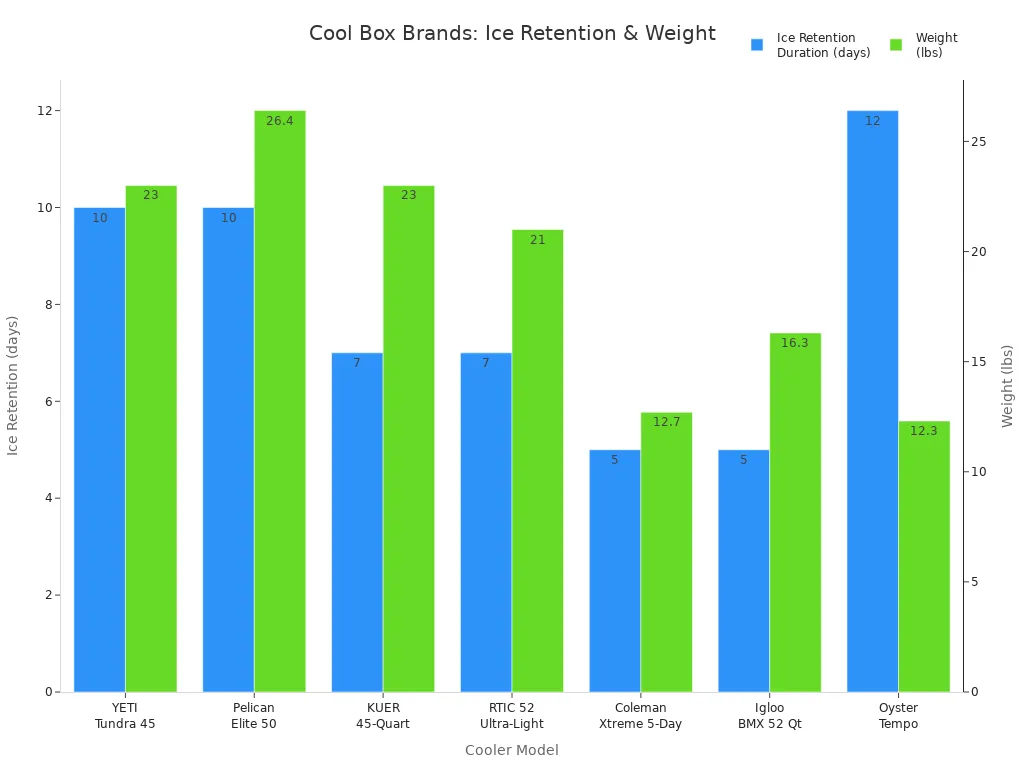
When you look at these details, you can pick a cooler that matches your trip length, group size, and budget. Some coolers give you more days of ice, while others are lighter or have more accessories. Always check the features that matter most for your adventure.
Test Results
Ice Retention
You want your cooler to keep food and drinks cold for as long as possible. Ice retention tests show how well each cooler performs in real conditions. Yeti coolers, such as the Roadie 48, can keep temperatures below 40°F for about 6.7 days and below 50°F for 7.5 days. RTIC coolers, like the SoftPak 30, hold ice for about 3.5 to 4 days. Urban Peak and Arctic Zone coolers keep ice for around 45 to 48 hours, even in high heat from 76°F to 93°F. These results come from both lab and outdoor tests. Yeti leads in cold retention and durability, while RTIC offers similar performance at a lower price. KUER specializes in rotomolded coolers, but independent ice retention test data is not widely available yet.
| Brand/Model | Below 40°F (days) | Below 50°F (days) | Ice Retention (hours) |
|---|---|---|---|
| Yeti Roadie 48 | 6.7 | 7.5 | 180 |
| RTIC SoftPak 30 | ~3.5 | ~4 | 84-96 |
| Urban Peak | – | – | 45-48 |
| Arctic Zone | – | – | 45-48 |
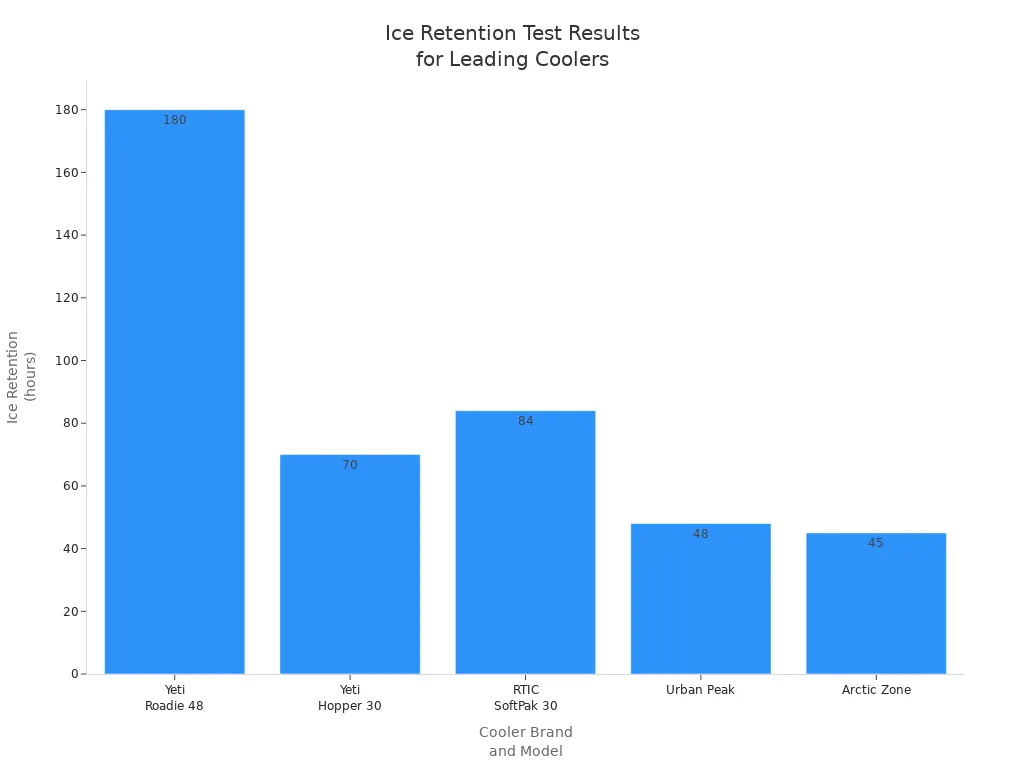
Tip: For the best retention, pre-chill your cooler and limit how often you open the lid.
Durability
You need a cooler that stands up to tough use. Rotomolded coolers, like those from KUER and Yeti, resist cracks and dents. Drop tests and rough handling show that these coolers keep their shape and protect your food. Strong hinges, thick walls, and tight gaskets help prevent leaks and damage. Many users report that their coolers last for years, even after many camping trips. You can use these coolers as seats or steps without worry. This makes them a smart choice for outdoor adventures.
Portability
A portable cooler should be easy to move, even when full. Testers check how coolers perform on different surfaces and in real-life situations. Here is what they found:
- Large, heavy coolers are harder to carry, especially when loaded.
- Portability scores look at more than just weight. Handle comfort and placement matter.
- Wheeled coolers get tested on pavement, grass, sand, and gravel.
- Good wheels roll smoothly and do not hit your heels.
- For coolers without wheels, testers check if one person can lift and carry them easily.
- Tests include loading coolers into cars, placing them on shelves, and carrying them to picnic spots.
- The best portable cooler combines light weight, strong handles, and good wheel design.
You should always think about where you will use your cooler. If you plan to walk long distances or cross rough ground, look for a model with sturdy wheels and comfortable handles.
Pros and Cons
Summary
When you choose an insulated box for your outdoor trips, you want to know what each brand does best and where it might fall short. The table below gives you a clear look at the main pros and cons for top brands, based on real user feedback and expert tests.
| Brand | Pros | Cons |
|---|---|---|
| Coleman | Affordable price, durable build, good ice retention for the cost, lightweight, helpful customer service | Not bear resistant, lid may not latch or stay open |
| Coho | Excellent insulation, high quality, low price, strong customer support | Hard to find, drain plug may leak, needs Costco membership |
| Maluna 70 | Holds ice up to 17 days, very durable, easy latches and lid | Heavy, bulky, not many accessory options |
| Orion Core 65 | Keeps ice for 14 days, great value, many add-ons, top customer service | No grip to open lid |
| Oyster Tempo | Extreme thermal efficiency, cools quickly, lightweight, unique design | Expensive, lid can get damaged, newer company |
You see that budget brands like Coleman and Igloo give you good value and easy use. Premium brands such as Maluna and Orion offer long ice retention and strong builds, but they can be heavy or costly. Oyster Tempo stands out for its fast cooling and light weight, but it costs more and the lid may not last as long.
KUER gives you a unique advantage. You get a product made with advanced technology, high-quality materials, and strict testing. The company holds over 50 patents and focuses on innovation. KUER’s large-scale manufacturing means you can trust the quality and consistency. If you want a box that lasts for many trips and offers new features, KUER is a smart choice for serious outdoor fans.
Tip: Think about what matters most for your adventure—price, durability, or special features—before you pick a brand.
Choosing the Right Insulated Cool Box
Trip Length
You should match your cooler to your trip length. For a short day trip or picnic, a cooler bag works best. It is light and easy to carry. If you plan a weekend camping trip, you need a hard-sided insulated cool box. These keep ice longer and protect your food. For week-long adventures, choose a large cooler with thick insulation like PU foam. This type holds ice for many days and keeps food safe.
Tip: Pre-chill your cooler before packing. This helps keep everything cold for longer.
Group Size
The number of people on your trip decides the size of your cooler. Use this table to find the right fit:
| Group Size | Cooler Capacity (Quarts) | Best Features |
|---|---|---|
| 1-2 people | 15 – 47 | Small cooler bag, easy to carry |
| 3-5 people | 54 – 100 | Medium cooler bag or hard cooler, balanced size |
| 6+ people | 106+ | Large cooler with wheels or strong handles |
A small group can use a compact cooler bag. Families or bigger groups need a larger cooler with more space and better insulation.
Transport
Think about how you will move your cooler. If you walk or hike, a soft cooler bag with a shoulder strap or backpack design is best. For car trips, you can pick a bigger hard-sided cooler or a travel cooler with wheels. Wheels and sturdy handles help you move heavy coolers over sand or gravel. If you travel by boat, look for a cooler with non-slip feet and a tight seal.
- Soft cooler bags: Best for walking or short trips.
- Hard coolers with wheels: Good for cars, boats, or rough ground.
Budget
You can find a cooler for every budget. Entry-level cooler bags cost less and work well for short trips. Mid-range hard coolers give you better ice retention and more features. Premium coolers cost more but last longer and keep food cold for days. Choose a cooler that fits your needs and budget.
Note: Brands like KUER, RTIC, and Igloo offer good value for families. Yeti and Pelican are great for long trips and large groups.
KUER Advantages
Features
You get more than just a cooler when you choose KUER. KUER uses one-piece roto-molded polyethylene construction. This design gives your cooler extreme durability. You can trust it to handle rough trips and heavy use. The materials are food-grade, eco-friendly, and UV-resistant. Your food and drinks stay safe and fresh, even in strong sunlight.
KUER coolers have thick polyurethane foam insulation. This keeps ice frozen for days. The freezer-style sealing gasket locks in cold air. You do not have to worry about leaks or warm spots. Stainless steel latches last for years. You can open and close your cooler many times without breaking the latch.
KUER adds smart design details to every cooler:
- Self-stopping hinges keep the lid open when you need both hands.
- Padlock holes let you secure your cooler at campsites or in your truck.
- Non-slip rubber feet stop the cooler from sliding.
- Nylon rope handles with textured grips make carrying easy.
- The drain valve with a recessed plug helps you empty melted ice quickly.
- Tie-down points let you mount your cooler safely on boats or vehicles.
You also get a 5-year free warranty. KUER stands behind its quality and wants you to feel confident on every trip.
Value
KUER gives you strong value in the insulated cool box market. You benefit from a company that controls every step of production. KUER operates five factories and two trading companies. The company makes its own raw materials and assembles each cooler in-house. This means you get consistent quality and fast delivery.
You can choose from a wide range of products. KUER offers soft cooler bags, backpack coolers, hard coolers, roto-molded boxes, injection coolers, blow-molded coolers, and ice buckets. You can customize size, color, logo, handle type, and even use sustainable materials. KUER supports both ODM and OEM projects.
KUER’s advanced equipment produces up to 1,500 cooler boxes every day. You get reliable supply and short lead times. The company’s R&D team has applied for over 50 patents. This shows a strong commitment to innovation. Quality control includes material testing, temperature checks, leak and load strength tests, and final inspections. KUER holds ISO 9001, BSCI, and GRS certifications.
You can count on KUER’s experienced sales team for smooth communication and on-time delivery worldwide. Your cooler will meet international standards and keep your food cold for days, wherever you travel.
You have many choices when picking an insulated cool box. Heavily insulated models like Yeti keep food cold longer but offer less usable space. Lighter coolers such as Coleman give you more room and are easier to carry. The table below shows how much space you actually get inside each cooler:
| Cooler Model | Usable Interior Space (%) |
|---|---|
| Yeti Tundra 45 Hard Cooler | ~29% |
| Coleman 52 Quart 316 Series | ~51% |
| Igloo BMX 52 Quart | ~48% |
| RovR RollR 60 Rolling Cooler | ~40% |
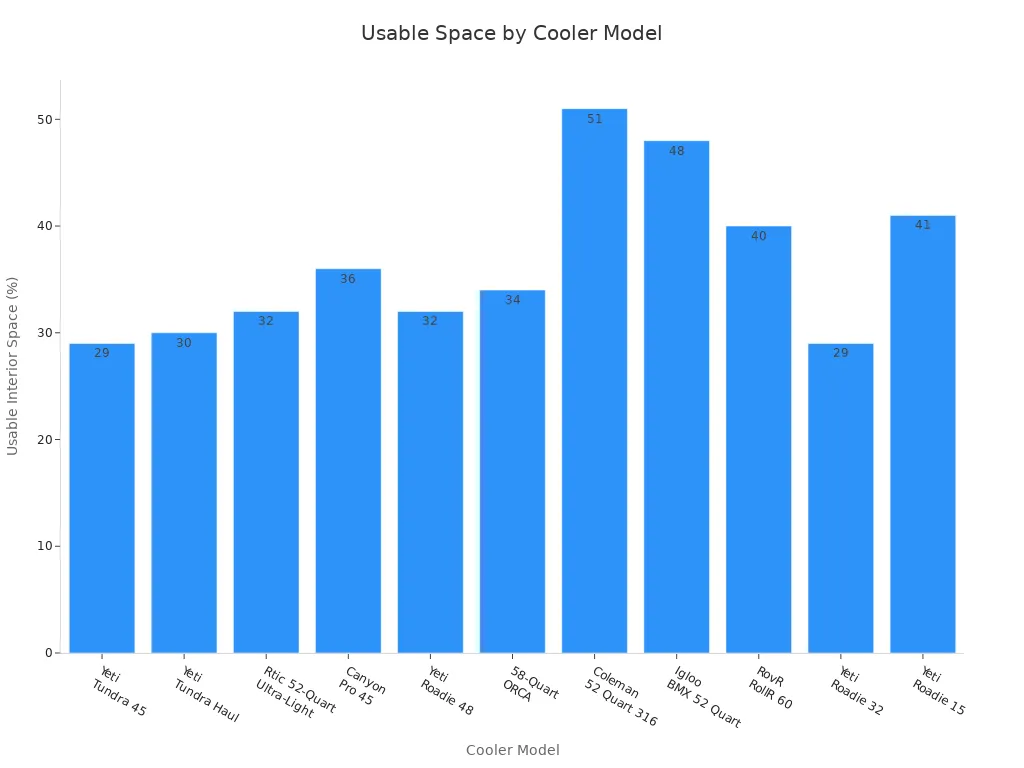
If you want the best cold retention, choose a hard cooler. For short trips, a cooler bag works well. You can use a cooler bag for hiking, picnics, or as a travel cooler. KUER stands out for its strong build, smart design, and reliable performance. Use this guide to find the right cooler bag for your next adventure.
FAQ
How do you maximize ice retention in your insulated cool box?
You should pre-chill your cooler before packing. Fill it with cold items and use large ice blocks or frozen bottles. Keep the lid closed as much as possible. Dry ice packs or sealed ice bottles work best for long trips.
What size cooler do you need for a weekend camping trip?
For two to four people, you need a cooler with a 45- to 65-quart capacity. This size holds enough food and drinks for two to three days. Always check the interior space, as insulation thickness can affect usable volume.
Can you use dry ice in all insulated coolers?
Not all coolers support dry ice. You should check the manufacturer’s guidelines. Rotomolded coolers, like those from KUER and Yeti, usually handle dry ice safely. Dry ice keeps items colder than regular ice but requires careful handling.
How do you clean your insulated cool box after use?
Empty the cooler and rinse it with warm, soapy water. Use a soft brush for tough spots. Rinse again and dry completely with the lid open. This prevents mold and odors. Some coolers have drain plugs for easy cleaning.

